
Congress and U.S. presidents routinely ask how the government will pay for education and healthcare, for cleaning the environment, for ensuring labor justice — all the human needs. But rarely, if ever, do they ask where the vast fortune they are flooding into the Pentagon budget will come from.
After the end of World War II, the U.S. government justified its massive military budget by claiming the Soviet Union was a threat to our country. Other small and weak socialist countries like the DPRK (North Korea), Vietnam and Cuba were deemed threats to the mighty United States, which attempted to put them down. Numerous other, short-lived, progressive governments in small countries were named threats and overthrown.
Once the Soviet Union had fallen in the early 1990s, the peace dividend was ephemeral. The U.S. claimed Iraq’s Saddam Hussein was a threat, then Serbia’s Slobodan Milosovic. Then the 9/11 terrorists were the threat. Then it was Libya’s Muammar Gaddafi, Syria’s Bashir al-Assad and Iran’s Ayatollahs.
But the existence of terrorists, or alternatively, the national leaders of various small countries, could not indefinitely justify constantly increasing funds for nuclear missile fleets, bombers, Navy vessels, foreign military bases, and a large standing army. It could not indefinitely justify a military budget greater than those of the next 9 countries combined, most of which are U.S. allies. A bigger threat had to be conceived to meet that demand.
As Secretary of Defense Lloyd J. Austin III revealed in the latest war budget this past March, the 2022 National Defense Strategy outlines the following “security priorities” for the U.S. Department of Defense:
- “Defending the homeland, paced to the growing multi-domain threat posed by the People’s Republic of China (PRC)”
- “Deterring strategic attacks against the United States” and its “allies” and “partners”
- “Deterring aggression, while being prepared to prevail in conflict when necessary — prioritizing the PRC challenge in the Indo-Pacific region, then the Russia challenge in Europe.”
- “Building a resilient joint force and defense ecosystem.”
Realistically, the United States warring class must establish threats as a precondition to its “full spectrum dominance,” a term coined by the major warmongers of the late 1990s and quickly implemented by President George W. Bush. It means simply that the U.S. will prevent any other country or group of countries from challenging its total global economic, political, financial, technological, or military hegemony. By any means necessary.
Thus, the Pentagon’s latest threats engineered specifically to justify filling its coffers and maintaining full spectrum dominance are China and Russia.
The U.S. financial-military-industrial complex is swallowing the national economy, and throwing humanity under the bus. It is depleting the capital infrastructure built over the country’s lifetime, despoiling the global landscape and, if not reined in, will incinerate all of civilization and most life on this planet.

Furthermore, as our society becomes increasingly militarized, we witness the blowback of the incessant violence of foreign wars in the mass shootings that take place everyday in our schools, malls, houses of worship, and private homes. We witness the construction of “Cop City” in Atlanta, aimed at accelerating the transformation of our domestic police into an occupying army, as the Pentagon transfers billions of dollars of outdated, surplus military equipment to local law enforcement. This strengthening of the weapons industry certainly strengthens the most fascistic forces in the United States.
While the five biggest armaments companies in the U.S. and top political donors within the defense industry contributed almost $285 million to both Democrats and Republicans from 1990–2022, the majority of that money (57%) went to the GOP, amounting to a nearly 33% donor boost overall for Republicans. Except during Clinton and Obama’s first terms, when the big armaments contributed more to the Democratic Party, weapons manufacturers have contributed anywhere from 12%–105% more to the GOP.
Nonetheless, in March, President Joe Biden requested $842 billion for the Pentagon for FY (Fiscal Year) 2024. This is an increase of $69 billion over the $773 billion requested for 2023 by the department of war (it’s a misnomer to call it defense). By including the annual amounts proposed for developing and building a new nuclear weapons arsenal — scheduled to eventually total $2 trillion, war spending is already acknowledged to reach $886 billion.
Yet there’s more. The tens of billions Congress keeps appropriating to keep the war in Ukraine going, at least $112 billion so far, is off the Pentagon’s books.
In addition, each year, Congress shamelessly pours additional tens of billions of dollars over and above the President’s request to subsidize imperialism’s war machine. Last year, pork-barrel lawmakers added $25 billion to the president’s proposal. In the next months, we can expect them to continue that shameless tradition.
According to defense analyst William Hartung, “Congressional add-ons could push total spending for national defense to as much as $950 billion or more for FY 2024. The result could be the highest military budget since World War II, far higher than at the peaks of the Korean or Vietnam Wars or the height of the Cold War.”
But that’s still not the end of it.
Tens of billions of our taxes are aimed at the activities of Homeland Security, which was created claiming to provide defense of the United States, as distinguished from the Pentagon’s more distant invasive operations — including more than 800 foreign military bases and numerous Naval fleets traversing the planet’s oceans.
The CIA and 16 or more other agencies tasked with spying on everybody (friend and foe) and sabotaging targeted governments take in untold truckloads of tax dollars.
The State Department receives tens of billions for financing foreign militaries, such as the Israeli and Egyptian militaries. The State Department’s budget funds the U.S. Agency for International Development, National Endowment for Democracy and other operations responsible for corrupting, sabotaging and subverting the societies of various countries, including Cuba, Venezuela, Iran, Nicaragua, Syria, Ukraine, and many others. Those that have defied demands to adopt policies friendly to U.S. corporations are especially targeted with these interventions.

There is also over $300 billion our country is obligated to spend to care for veterans of the numerous wars the U.S. has initiated.
Yet there’s more.
Since World War II, the United States government has chosen to borrow money from the rich, instead of taxing them, to pay for its numerous, expensive wars and for the huge, proliferating war machine, all of which mainly benefits the rich. These loans are to be repaid with interest. The financial burden is thus kicked down the road, attempting to avoid antagonizing the working class and any concurrent resistance. Not specifically raising war taxes, however, does not avoid the exquisite suffering of military families, our communities, and the hundreds of millions living and dying in the invaded nations.
The Pentagon calculated the direct cost of the wars on Afghanistan, Iraq and Syria between 2001 and 2021 to be $1.6 trillion. That’s $8,300 from each of us taxpayers. Not one of the countries the U.S. invaded during that time frame had threatened the security of the 335 million residents of the United States. Surely we could have put those dollars to good use.
Importantly, the Cost of War Project at Brown University included indirect costs. Their figure for the Bush–Obama–Trump–Biden “war-related spending” from 2001 “through FY 2022 with estimated obligations to veterans’ care through 2050” totals at least a staggering $8 trillion. Other estimates raise that to an even more astounding $21 trillion. Even this outrageously high number does not take into account the cost — which the U.S. government now owes — of repairing the destroyed infrastructure and other horrendous damages suffered by the people of those countries attacked by the U.S.
By including national war-debt payments and all the other war spending outlined above, William Hartung and Mandy Smithberger calculated the total military budget for FY 2020 as north of $1.25 trillion. Back then the Pentagon “base” budget was $544.5 billion. The FY 2024’s base budget is at least $300 billion greater. So it now easily surpasses that monstrous amount and likely greater than $1.5 trillion.
Is that the final amount the United States is throwing to manifest war?
No.
In reality, the military budgets of the U.S.’s NATO allies should be included in what the U.S. spends on weapons and war. Even though the U.S.’s NATO partners are sovereign countries, their militaries are largely an extension of the Pentagon and usually march in lockstep with U.S. foreign policy. NATO — read “the extended arms of the U.S. Pentagon” — requires member forces to purchase quantities of U.S.-made weaponry for “interoperability.” So we could add up to $300 billion to the budgets that feed the war machine.
In addition to NATO members we should include South Korea’s military budget because in time of war the U.S. commands the South Korean military. But why not include all U.S. military allies whose biggest spenders are Saudi Arabia, Japan, South Korea and Australia? Doing so would raise the Pentagon’s budget by $550 billion.
Now we’re approaching $2 trillion per year that the Pentagon can leverage.

But let’s consider just the amount taken from U.S. taxpayers by the financial-military-industrial complex, as we should leave veterans’ benefits intact.
What else could $1.2 trillion buy?
The National Priorities Project (NPP) has done the basic arithmetic. The numbers below are based on NPP’s alternative ways to spend that enormous sum.
Those tax dollars could be used to pay for all the following each year:
- 5 million university scholarships
- 2 million elementary school teachers
- Head start slots for all of the 3.8 million three-year-olds in the U.S.
- 5 million public housing units
- 2 million clean energy jobs
- Providing 10 million households with wind and solar power
- Healthcare for all of the 38 million low-income adults in the U.S.
- Healthcare for all of the 4.2 million children in the U.S. currently without it
- 2 million registered nurses
- 2.5 million $15/hr jobs with benefits (there are 1.2 million unemployed 16–24 year olds in the U.S., and real unemployment is at least double the official rate)
How realistic is it to stop squandering the treasure, natural resources and technical skills of our working class and redirect Pentagon spending to benefit the true needs of this country?
In 2020, Congressional House members Barbara Lee of California and Mark Pocan of Wisconsin, and Senator Bernie Sanders of Vermont, introduced an amendment to the National Defense Authorization Act that would have cut Pentagon spending for FY 2021 by just 10%. It gained the votes of 93 members of the House and 23 members of the Senate, almost all Democrats. The amendment lost.
In 2020, House member Barbara Lee of California introduced a resolution to cut military spending by $350 billion. A little over one month later, she and Mark Pocan created a Defense Spending Reduction Caucus.
In 2019, the Poor People’s Campaign published a “moral budget” that also called for cutting the military budget by $350 billion.
Before the demise of the Eurasian socialist bloc in the early 1990s, there was a growing effort led by international president of the International Association of Machinists William Winpisinger to move funding away from war to fund civil society. Today, there is again a germ of a new such effort at conversion from a militarized to a civilized economy. More accurately, it is a “just transition” that guarantees equivalent jobs or wages to the workers moving out of the war economy industries and into peace economy jobs.
The “Move the Money for Human Needs Campaign” organizes at the level of city governments to coalesce unions and social-needs organizations to draft, lobby for, and pass resolutions in city councils demanding drastic reductions in military spending and using the billions of dollars saved to address the human needs of our people. One important example is taking place now in the biggest city in the country, New York City, where a broad coalition of trade unions, community, faith and peace organizations has introduced such a resolution.
All of these initiatives are worth building upon. We must create local coalitions to join the Move the Money campaign, participate with the Poor People’s Campaign and press members of Congress to join the Defense Spending Reduction Caucus. And we should be electing leaders who will follow the people in building a new economy that is just, green, and peaceful.
Images: Tax the rich, house the poor, money for jobs, not the war by People’s World (CC BY-NC 2.0); high school students participate with a Military Families Speak Out action by Military Families Speak Out (Facebook); #HandsOffCuba by People’s World (CC BY-NC 2.0); End endless wars by Peace Action New York State (Facebook)


 Join Now
Join Now